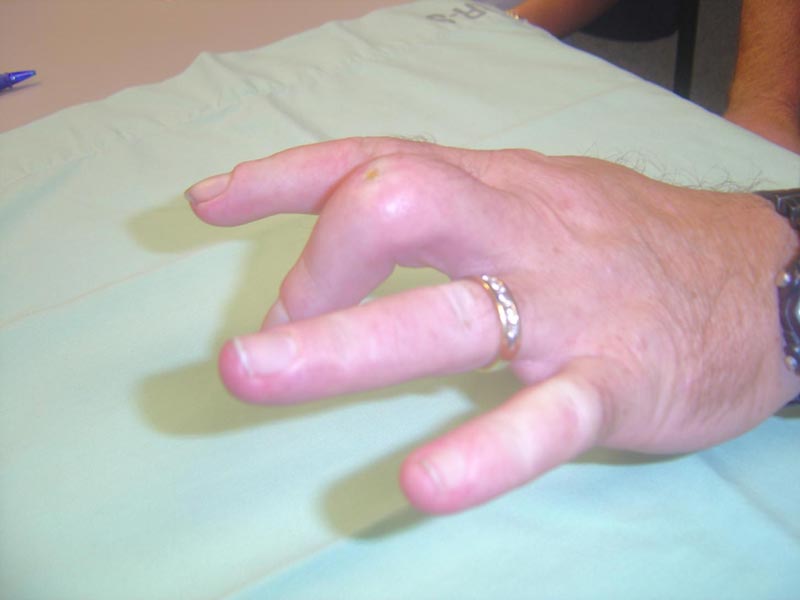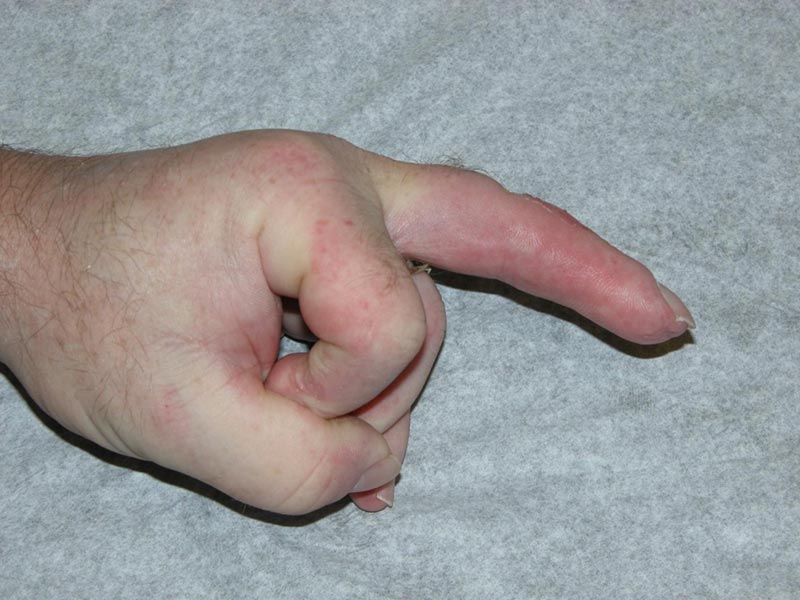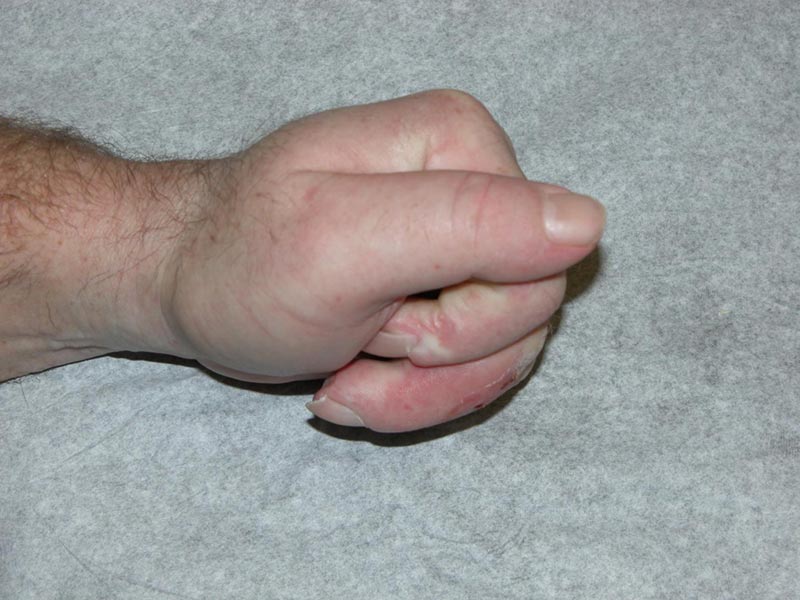
The Stiff Finger
There are many causes of finger stiffness. Usually finger stiffness is due to an injury to the hand or wrist, especially a previous fracture, ligament injury or surgery. Finger stiffness can be debilitating and may severely impair hand function.
The first-line treatment for stiffness is hand therapy, often using splints with springs or rubber bands on them to stretch out the digit. A certified hand therapist will be most effective in mobilizing the digit. Therapy is continued for as long as it continues to increase motion. Occasionally, a steroid injection may be helpful to decrease inflammation and allow therapy to progress.
Once motion ‘plateaus’, i.e. stops improving, a decision is made. If the finger motion is good enough that the residual stiffness isn’t much of a problem, then no further treatment is necessary. On the other hand, if residual stiffness impairs hand function, then a surgical release should be considered.
All other issues should usually be resolved before releasing the joints. Specifically, the bones of the finger should be healed in good, or at least ‘acceptable’, position. If they’re not, then they will usually need to be surgically corrected as a ‘first stage’ surgery. If the joints are injured, they will either need to be repaired or reconstructed, if possible, again prior to any motion-gaining surgery. Not every injured joint can be salvaged, in which case joint fusions may be necessary. Fusion involved permanently stiffening a joint to decrease pain and increase stability. Following any ‘first stage’ surgery, there is at least a 3-4 month waiting period for inflammation and swelling to subside before the surgical release is performed. It’s better to have the release performed within a year of the injury or surgery that led to the stiffness, but that’s not always possible. It’s easiest if only one finger is involved. The more fingers and the more joints operated on simultaneously, the more pain and swelling occur, the more the time and attention of therapy are divided, and the more difficult it is to ‘focus’ on any particular finger or joint. Consequently, the results may not be as good for each individual digit.
Surgical release involves releases scar from one side of the finger to regain motion in one direction, either flexion or extension. Attempts to operate on both sides of the finger at the same time do poorly, due to excessive swelling and scar formation; these procedures usually fail. If both flexion and extension need to be recovered, this can be accomplished with two separate surgeries, at least 3-4 months apart. The most important motion to regain is flexion, which is used to make a fist. During surgery to regain flexion, scar is removed from the involved joint(s) and from the scarred down extensor tendon.
Joint Release
After surgery, the wound should be kept clean and dry for 3 days. Bathing is safer than showering, because the hand can be kept out of the bath tub. Wrap a towel around the hand and then place it inside a plastic bag secured with rubber bands. If a bathtub is not available, the best cast protector is made by Walgreens. After 3 days the wound can get wet in the shower, blotted dry, and band-aids or a light dressing that will not limit motion can be applied. Please do not get the wound dirty, or submerge it under water, until the stitches come out, 2-3 weeks after surgery.
Surgical release is an outpatient procedure that is usually very effective to regain flexion/bending. However, the main issue is the serious time commitment required for hand therapy after surgery. The surgical release is performed in the morning. Therapy begins that afternoon. Hand therapy is intensive, often 5 days/week for a month, then 4 days/week for a month, then 3 days/week for a month. That’s a big commitment. Some people need less, but that’s not something to count on until after hand therapy is begun and it’s determined how finger motion progresses. The goal is to maintain the motion achieved at the time of surgery. A home program is performed 7 days/week for many months, often for a year.
The surgery itself is not very painful, but the therapy can be painful and it’s often a good idea to take a pain pill before therapy if someone else can drive you. Most people who work with the therapist and do their home program (performing motion exercises several times a day, every day, on their own) regain excellent finger flexion and excellent hand function. Note that motion is much improved immediately after surgery, then decreases somewhat for the first two weeks due to swelling and inflammation, but then increases if the therapy home program are carried out.
Obtaining finger extension is also possible. The proximal interphalangeal (PIP) joint is the joint most commonly stuck in flexion. Open surgery is not very effective for regaining PIP joint extension. To regain PIP joint extension, the best way is probably by using a ‘digit widget’. The digit widget is a device that is attached to the middle finger bone. This involves a minor outpatient surgery. The digit widget attaches to a rubber band, which is attached to a removable Velcro glove that is worn on the hand. This rubber band places an extension force on the PIP joint 24 hours a day. Therapy is not very intensive, but is performed roughly once a week, in order to check the digit widget’s position and often supplement it with splinting of the adjacent metacarpophalangeal (MP) joint.
After surgery to place the digit widget, keep everything clean and dry for 2 days. Bathing is safer than showering, because the hand can be kept out of the bath tub. Wrap a towel around the hand and then place it inside a plastic bag secured with rubber bands. If a bathtub is not available, the best cast protector is made by Walgreens. After 2 days, the digit widget and its pins can get wet in the shower. After showering, use a Q-tip dipped in hydrogen peroxide to remove any blood that has dried around the skin; this is important to avoid infection. Do not get the pins dirty or submerge the finger under water until 24 hours after pin removed in clinic at 6 weeks after surgery. Pin removal is not very painful at all.
The digit widget is left in place for 6 weeks and then removed in the office, which also doesn’t hurt very much. Night splints are worn for 6 months to minimize the chance of recurrence. The digit widget is usually very effective. If you’re interested, you can attain more information about the digit widget at: http://www.handbiolab.com/products/digit-widget/ (Figures 32-35).
So if a stiff finger is causing hand dysfunction and therapy isn’t working, be aware that effective surgical options exist. However, the post-operative hand therapy is very intensive, and time must be scheduled to attend therapy for the surgery to be effective. Hand therapy is a necessary and integral part of the treatment, as is the home program. It’s a lot of time, hard work, and commitment, but with dedication and persistence the results can be very rewarding.




